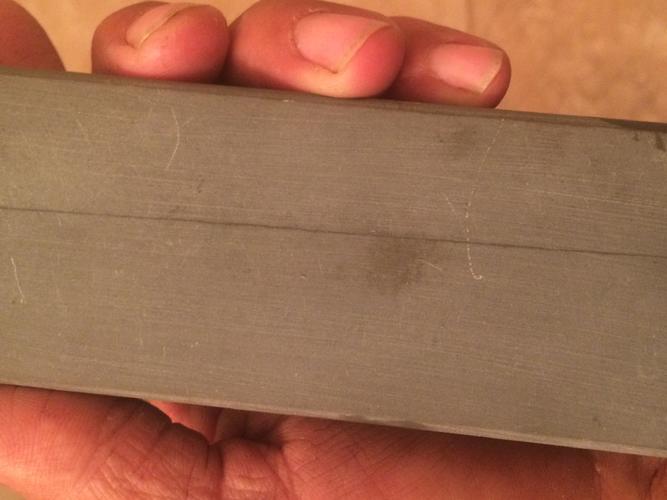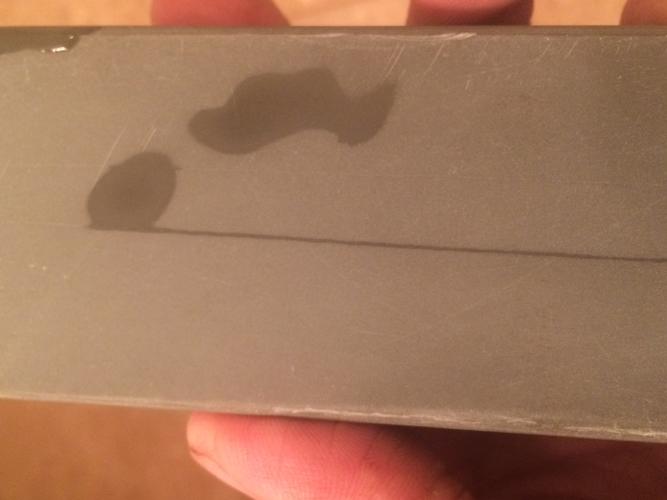Results 1 to 10 of 22
Thread: Crack in a C-nat
Hybrid View
-
08-24-2017, 07:30 PM #1
 Crack in a C-nat
Crack in a C-nat
I noticed last night that my C-nat has a crack running down the length of the stone. It is all the way through the stone, but not the whole length yet. Somehow it is not hurting the finishing qualities of this stone. The stone is from woodcraft and says it's from the guangxi province. It is a good finisher and have used it on all my razors, and they all shave close and comfortable. Is there a way to save this stone from fully cracking? Or would it cost less to replace it for around $35? It is a very hard stone and very difficult to lap.
Bottom side

Top side

Thanks in advance on the help
-
08-24-2017, 07:39 PM #2Senior Member



- Join Date
- Dec 2014
- Location
- Virginia, USA
- Posts
- 2,224
Thanked: 481
You could consider sealing it. In this case I would probably sacrifice the ability to use the back of the hone and glue it to a wood base too. It's easy to say 'just replace it cause they're cheap' but there's no guarantee the one you get will be as good as this one. So I would try to save it.
-
08-24-2017, 07:45 PM #3

Thanks Marshall. I only use the one side. It's just way too hard to lap to bother with the back. But I was thinking of using epoxy to adhere it it something, didn't think wood would work with the water involved with honing, warpage being my main concern. What type of epoxy and what to adhere it to? Are my main questions?
-
08-24-2017, 07:52 PM #4Senior Member



- Join Date
- Dec 2014
- Location
- Virginia, USA
- Posts
- 2,224
Thanked: 481
Wood is probably do-able if it's coated with a nice water resistant polyurethane sealer. Which is also what I used to seal the sides and bottom of my Jnat. So I was thinking glue to backer, coat both with sealer, and hopefully stop the crack in it's tracks.
Glass would probably also work. There are suggestions for glues to glass backers here:
http://straightrazorpalace.com/hones...ros-glass.html
I know it's not a Shapton Pro, but same principle I imagine.Last edited by Marshal; 08-24-2017 at 08:09 PM.
-
08-24-2017, 08:45 PM #5Senior Member


- Join Date
- Jul 2011
- Posts
- 2,110
Thanked: 459
Glue it to a base. Stable wood or glass.
-
08-24-2017, 08:58 PM #6Sharp Minded Citizen

- Join Date
- Oct 2013
- Location
- Bucharest
- Posts
- 434
Thanked: 156
That's a strange way for it to crack...leads me t belive it was cut with the laiers running perpendicular to the stone face....
that means that you are looking at the layers when you look at the hone working surface...if this is the case and a layer separation has started it might go all the way trough in time no matter what you do....stone as basicaly any other material expands and contracts in response to temperature and hidratation....this is the way stones have cracked from the begining of time...
Cracks could be one of two...
Stable...cracks that are promoted by shock or handling during manufacturing practices...some mines just blow sp stock and pickup the pieces for cutting...like modern coticule mining
These cracks tend to be in healthy stones and are usualy stable.
Unstable cracks are usualy the result of mineral oxidaton in between the layers ...water and air sip in and the oxides usualy take up more volume then the original mineral and exert a pressure effect between the layers promoting a crack...the crack eventualy gets larger...oxidation accelerates and the stone finaly separates.
As the guys before said...best thing would be to let it dry...seal the crack with ca Glue..sand the excess off then seal this face and the sides and turn it arround and use the other face if it is usable.
Sealing usualy stops the crack progression.
Glueing it to a wood base has its advantages and disadvantages...you will have to find a way to seal the wood so that water does not promote cracks...if not sealed the wood expands and shrinks while it absorbs water and gets dry...this kind of tension and stress transferes to the glued hone in time....so it is important for the wood to be sealed.
Also if gluing it to a wood base is what you decide...do it in such a way as if you want to ever unglue it you can do it without breaking the stone.
If you decide to laquer it you should try a thick hard laquer that dries to a glassy hard finish...like cashew...or bar-top epoxy.
Thin layers of laquer usualy stop the water sipping in but are easier to chip and ware over time and eventualy they stop beeing airtight...a stone is hard and you usualy hit it against other hard stuff.
Thin laquer works well if you lighthandle the stone or for naguras...etc.
That's all you need to know actualy.
-
-
08-24-2017, 09:15 PM #7

Thank you ovidiucotiga! I'll find where to get my hands on some cashew laquer, and give it a go. But if it does end up cracking all the way it's not that big of a deal, as they are inexpensive. And also I do know more about what I am looking at for this type of hone, so I should be able to pick out another good one instead of just lucking out like when I bought this one.
-
08-24-2017, 09:03 PM #8

That probably would work, once seals really good. Thanks marshal.


 24Likes
24Likes LinkBack URL
LinkBack URL About LinkBacks
About LinkBacks






 Reply With Quote
Reply With Quote